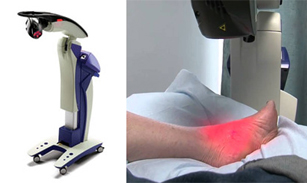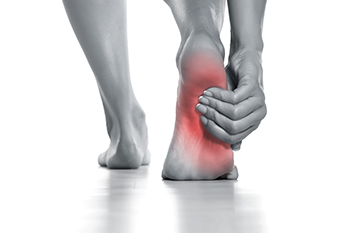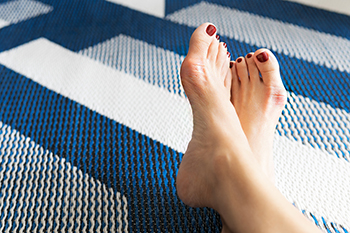Wesley Chapel
(813) 973-3535Call or Text
September 2023
Healing Achilles Pain With Therapeutic Laser

Achilles pain, often caused by conditions such as Achilles tendinitis or tendonitis, can be excruciating and debilitating. Fortunately, advances in medical technology have introduced therapeutic laser therapy as a promising treatment option for this common ailment. Therapeutic laser, also known as low-level laser, or cold laser therapy, utilizes specific wavelengths of light to penetrate deep into the tissues surrounding the Achilles tendon. This non-invasive procedure promotes cellular repair, reduces inflammation, and relieves pain without the need for surgery or medication. During a therapeutic laser session, a podiatrist will target the affected area with the laser device. The energy from the laser stimulates cellular activity, enhancing blood circulation and accelerating the body's natural healing process. This can effectively alleviate Achilles pain and discomfort over time. Additionally, therapeutic laser therapy is a painless and quick procedure with minimal side effects, making it a safe and viable option for individuals seeking relief from Achilles pain. It is essential to consult a podiatrist to determine if therapeutic laser therapy is suitable for your specific condition and to create a personalized treatment plan. With this innovative approach, many individuals can find lasting relief from Achilles pain and regain mobility and quality of life. If you are considering this form of treatment, it is strongly suggested that you speak to a podiatrist who can determine if this is the right choice for you.
MLS Laser Therapy is a successful alternative for treating any pain you may be experiencing related to certain podiatric conditions. If you are interested in MLS Laser Therapy, consult with one of our podiatrists from New Tampa Foot & Ankle. Our doctors will assess your condition and provide you with quality foot and ankle treatment.
MLS Laser Therapy
Multiwave Locked System (MLS) Laser Therapy is a patented, FDA-cleared technology that helps relieve pain and inflammation from a number of podiatric conditions, including:
- Heel Pain
- Plantar Fasciitis
- Sports Injuries
- Wounds
- Achilles Tendonitis
- Arthritis
- Neuropathy
- Neuromas
MLS Laser Therapy is an ideal alternative to surgery and prescription medication, as it has no negative side effects and encourages accelerated healing. Among its many clinical benefits, MLS Laser Therapy also:
- Reduces swelling due to bruising or inflammation
- Blocks pain
- Reduces formation of scar tissue
- Improves nerve function
If you have any questions, please feel free to contact our office located in Wesley Chapel, FL . We offer the newest diagnostic and treatment technologies for all your foot care needs.
Wounds That Don't Heal Need to Be Checked
Causes and Effective Remedies for Heel Pain

Heel pain is a common ailment that can disrupt daily life and activities. One of the primary culprits is plantar fasciitis, which occurs when the thick band of tissue known as the plantar fascia becomes inflamed or irritated. The plantar fascia is found on the bottom of the foot, and connects the heel to the toes. Plantar fasciitis often results from overuse, wearing improper footwear, or a sudden increase in physical activity. Another common cause of heel pain is Achilles tendonitis, which affects the Achilles tendon at the back of the heel, usually as a result of excessive strain or overuse. To alleviate heel pain, it is beneficial to rest and elevate the affected foot. Wearing proper footwear with adequate arch support can significantly help, in addition to wearing custom orthotic inserts. Performing stretching exercises for the calf muscles and Achilles tendon also can aid in recovery. In severe cases, surgical intervention may be necessary. If you are experiencing heel pain, it is strongly suggested that you make an appointment with a podiatrist who can determine the cause and offer treatment options that are right for you.
Many people suffer from bouts of heel pain. For more information, contact one of our podiatrists of New Tampa Foot & Ankle. Our doctors can provide the care you need to keep you pain-free and on your feet.
Causes of Heel Pain
Heel pain is often associated with plantar fasciitis. The plantar fascia is a band of tissues that extends along the bottom of the foot. A rip or tear in this ligament can cause inflammation of the tissue.
Achilles tendonitis is another cause of heel pain. Inflammation of the Achilles tendon will cause pain from fractures and muscle tearing. Lack of flexibility is also another symptom.
Heel spurs are another cause of pain. When the tissues of the plantar fascia undergo a great deal of stress, it can lead to ligament separation from the heel bone, causing heel spurs.
Why Might Heel Pain Occur?
- Wearing ill-fitting shoes
- Wearing non-supportive shoes
- Weight change
- Excessive running
Treatments
Heel pain should be treated as soon as possible for immediate results. Keeping your feet in a stress-free environment will help. If you suffer from Achilles tendonitis or plantar fasciitis, applying ice will reduce the swelling. Stretching before an exercise like running will help the muscles. Using all these tips will help make heel pain a condition of the past.
If you have any questions please contact our office located in Wesley Chapel, FL . We offer the newest diagnostic and treatment technologies for all your foot and ankle needs.
Children’s Foot Posture

Children’s foot posture refers to the positioning and alignment of the feet when a child is standing, walking, or engaged in other weight bearing activities. It is an essential aspect of overall lower limb and musculoskeletal health and can affect walking patterns, such as pigeon toes, tiptoeing, and out turned feet. Foot posture is typically described in terms of three main categories. The first one is normal foot posture, in which the foot maintains a neutral alignment. Second is flat feet, and the entire sole lies flat on the ground. Finally, high arched feet exists when an individual has abnormally high arches. Children’s foot posture develops from birth to eight years of age. If sensory systems in a child’s brain provide incorrect or unclear information, there can be inefficient muscle patterns and delayed gross motor skill development. For children with joint hypermobility, where joints are overly flexible due to elastic ligaments, the brain compensates using muscles to stabilize the joints. This imbalance in muscle strength can lead to alignment issues, muscle fatigue, and posture control problems. To understand the mechanics of your child’s foot development, it is suggested that you make an appointment with a podiatrist who can examine your child’s feet and address any emerging issues.
Making sure that your children maintain good foot health is very important as they grow. If you have any questions, contact one of our podiatrists of New Tampa Foot & Ankle. Our doctors can provide the care you need to keep you pain-free and on your feet.
Keeping Children's Feet Healthy
Having healthy feet during childhood can help prevent medical problems later in life, namely in the back and legs. As children grow, their feet require different types of care. Here are some things to consider...
Although babies do not walk yet, it is still very important to take care of their feet.
Avoid putting tight shoes or socks on his or her feet.
Allow the baby to stretch and kick his or her feet to feel comfortable.
As a toddler, kids are now on the move and begin to develop differently. At this age, toddlers are getting a feel for walking, so don’t be alarmed if your toddler is unsteady or ‘walks funny’.
As your child gets older, it is important to teach them how to take care of their feet.
Show them proper hygiene to prevent infections such as fungus.
Be watchful for any pain or injury.
Have all injuries checked by a doctor as soon as possible.
Comfortable, protective shoes should always be worn, especially at play.
If you have any questions please feel free to contact our office located in Wesley Chapel, FL . We offer the newest diagnostic and treatment technologies for all your foot and ankle needs.
It's Time for Beautiful Feet
Definition and Causes of Bunions

Bunions are bony protrusions at the base of the big toe and are more than just a foot concern as they can impact daily comfort and mobility. Medically known as hallux valgus, bunions develop gradually as the top of the big toe leans toward the second toe, causing the joint to jut out. Genetics play a role, as does wearing improper footwear, like high heels. The constant pressure and friction can exacerbate the misalignment, leading to pain and inflammation. Bunions are not uncommon. They affect a substantial portion of the population, and women tend to be more prone due to footwear choices. Recognizing the early signs like swelling, redness, and discomfort, can prompt proactive measures. Seeking advice from a podiatrist and opting for appropriate footwear can alleviate symptoms and potentially slow down the progression of bunions. If you have developed a bunion, it is strongly suggested that you are under the care of a podiatrist who can offer you preventive, relief, and treatment options.
If you are suffering from bunions, contact one of our podiatrists of New Tampa Foot & Ankle. Our doctors can provide the care you need to keep you pain-free and on your feet.
What Is a Bunion?
A bunion is formed of swollen tissue or an enlargement of boney growth, usually located at the base joint of the toe that connects to the foot. The swelling occurs due to the bones in the big toe shifting inward, which impacts the other toes of the foot. This causes the area around the base of the big toe to become inflamed and painful.
Why Do Bunions Form?
Genetics – Susceptibility to bunions are often hereditary
Stress on the feet – Poorly fitted and uncomfortable footwear that places stress on feet, such as heels, can worsen existing bunions
How Are Bunions Diagnosed?
Doctors often perform two tests – blood tests and x-rays – when trying to diagnose bunions, especially in the early stages of development. Blood tests help determine if the foot pain is being caused by something else, such as arthritis, while x-rays provide a clear picture of your bone structure to your doctor.
How Are Bunions Treated?
- Refrain from wearing heels or similar shoes that cause discomfort
- Select wider shoes that can provide more comfort and reduce pain
- Anti-inflammatory and pain management drugs
- Orthotics or foot inserts
- Surgery
If you have any questions, please feel free to contact our office located in Wesley Chapel, FL . We offer the newest diagnostic and treatment technologies for all your foot care needs.












